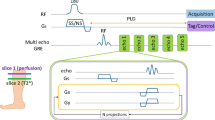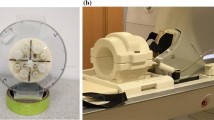Abstract
This study assessed the effects of cooling on blood flow and intramuscular water content in human skeletal muscles after exercise using magnetic resonance imaging. In six male subjects, their legs were randomly assigned to be control or to be cooled. All subjects performed ankle dorsiflexion exercise inside an imaging magnet and after exercise, an ice bag was placed on the ankle dorsiflexors of the cooled leg. Flow-sensitive images, which reflect both perfusion and intramuscular water, were obtained before and up to 270 s post-exercise at 30-s intervals. The flow-sensitive alternating inversion recovery (FAIR) images, which extract only the perfusion change, were also obtained. Signal intensity (SI) in the ankle dorsiflexors was estimated before and after exercise in both flow-sensitive and FAIR images. On the flow-sensitive images, the control leg increased SI 30–270 s after exercise (P<0.05), but the cooled leg showed no significant change. On the FAIR images, the control leg increased SI 30–270 s post-exercise (P<0.05), while the cooled leg increased SI 30–150 s and 210 s after exercise (P<0.05). The findings suggest that cooling attenuates the perfusion elevation and prevents the oedema formation in skeletal muscle immediately after exercise.



Similar content being viewed by others
References
Clarke RSJ, Hellon RF, Lind AR (1958) Vascular reactions of the human forearm to cold. Clin Sci 17:165–179
Coté DJ, Prentice WE, Hooker DN, Shields EW (1988) Comparison of three treatment procedures for minimizing ankle sprain swelling. Phys Ther 68:1072–1076
Daanen HAM, Van de Linde FJG, Romet TT, Ducharme MB (1997) The effect of body temperature on the hunting response of the middle finger skin temperature. Eur J Appl Physiol 76:538–543
Dolan MG, Thornton RM, Fish DR, Mendel FC (1997) Effects of cold water immersion on edema formation after blunt injury to the hind limbs of rats. J Athl Train 32:233–237
Fleckenstein JL, Canby RC, Parkey RW, Peshock RM (1988) Acute effects of exercise on MR imaging of skeletal muscle in normal volunteers. Am J Roentgenol 151:231–237
Fleckenstein JL, Haller RG, Lewis SF, Archer BT, Barker BR, Payne J, Parkey RW, Peshock RM (1991) Absence of exercise-induced MRI enhancement of skeletal muscle in McArdle’s disease. J Appl Physiol 71:961–969
Fox RH, Wyatt HT (1962) Cold-induced vasodilatation in various areas of the body surface of man. J Physiol (Lond) 162:289–297
Ho SSW, Illgen RL, Meyer RW, Torok PJ, Cooper MD, Reider B (1995) Comparison of various icing times in decreasing bone metabolism and blood flow in the knee. Am J Sports Med 23:74–76
Karunakara RG, Lephart SM, Pincivero DM (1999) Changes in forearm blood flow during single and intermittent cold application. J Orthop Sports Phys Ther 29:177–180
Le Rumeur E, De Certaines J, Toulouse P, Rochcongar P (1987) Water phases in rat striated muscles as determined by T2 proton NMR relaxation times. Magn Reson Imaging 5:267–272
Lewis T (1930) Observations upon reactions of vessels in human skin to cold. Heart 15:177–208
Matsen FA, Questad K, Matsen AL (1975) The effects of local cooling on postfracture swelling: A controlled study. Clin Orthop 109:201–206
Maw GJ, Mackenzie IL, Taylor NAS (1998) Human body-fluid distribution during exercise in hot, temperate, and cool environments. Acta Physiol Scand 163:297–304
McMaster WC, Liddle S (1980) Cryotherapy influence on posttraumatic limb edema. Clin Orthop 150:283–287
Paddon-Jones DJ, Quigley BM (1997) Effect of cryotherapy on muscle soreness and strength following eccentric exercise. Int J Sports Med 18:588–593
Sendowski I, Savourey G, Besnard Y, Bittel J (1997) Cold induced vasodilatation and cardiovascular responses in humans during cold water immersion of various upper limb areas. Eur J Appl Physiol 75:471–477
Sendowski I, Savourey G, Launay J-C, Besnard Y, Cottet-Emard J-M, Pequignot J-M, Bittel J (2000) Sympathetic stimulation induced by hand cooling alters cold-induced vasodilatation in humans. Eur J Appl Physiol 81:303–309
Shepherd JT, Rusch NJ, Vanhoutte PM (1983) Effect of cold on the blood vessel wall. Gen Pharmacol 14:61–64
Sjøgaard G, Saltin B (1982) Extra- and intracellular water spaces in muscles of man at rest and with dynamic exercise. Am J Physiol 243:R271–R280
Swenson C, Swärd L, Karlsson J (1996) Cryotherapy in sports medicine. Scand J Med Sci Sports 6:193–200
Taber C, Contryman K, Fahrenbruch J, LaCount K, Cornwall M (1992) Measurement of reactive vasodilatation during cold gel pack application to nontraumatized ankles. Phys Ther 72:294–299
Thorsson O, Lilja B, Ahlgren L, Hemdal B, Westlin N (1985) The effect of local cold application on intramuscular blood flow at rest and after running. Med Sci Sports Exerc 17:710–713
Yanagisawa O, Niitsu M, Yoshioka H, Goto K, Kudo H, Itai Y (2003) The use of magnetic resonance imaging to evaluate the effects of cooling on skeletal muscle after strenuous exercise. Eur J Appl Physiol 89:53–62
Yoshioka H, Itai Y (1996) Magnetic resonance imaging of isolated skeletal muscles: Osmotic influence. Invest Radiol 31:359–363
Acknowledgements
The authors would like to thank the medical staff in the Department of Radiology, University of Tsukuba for helpful comments and assistance. Our sincere thanks are extended to all subjects participating in this study.
Author information
Authors and Affiliations
Corresponding author
Rights and permissions
About this article
Cite this article
Yanagisawa, O., Kudo, H., Takahashi, N. et al. Magnetic resonance imaging evaluation of cooling on blood flow and oedema in skeletal muscles after exercise. Eur J Appl Physiol 91, 737–740 (2004). https://doi.org/10.1007/s00421-004-1060-2
Accepted:
Published:
Issue Date:
DOI: https://doi.org/10.1007/s00421-004-1060-2




